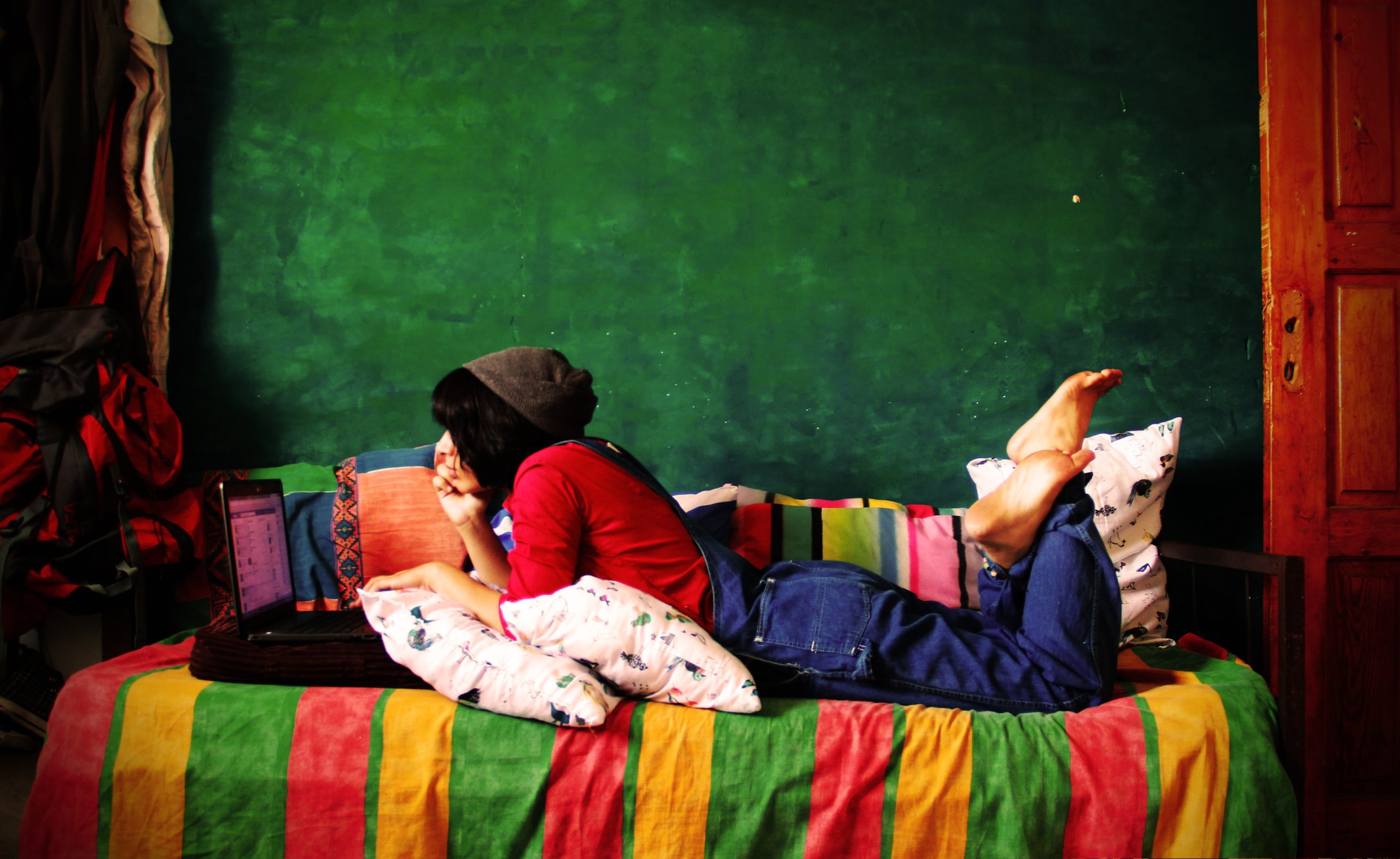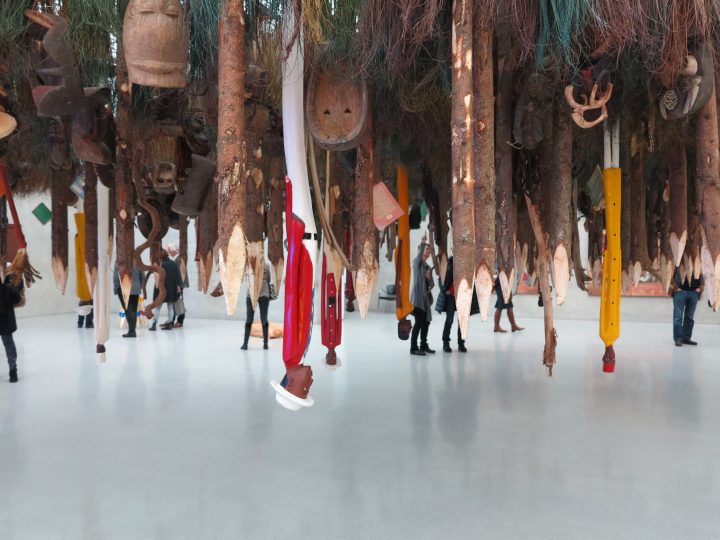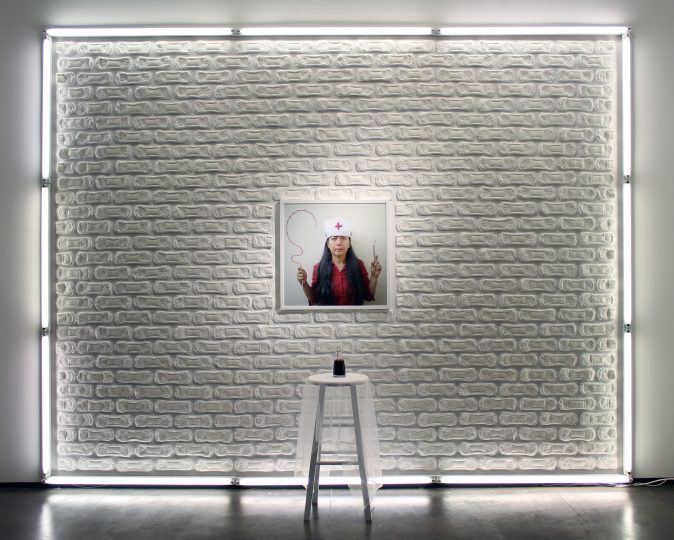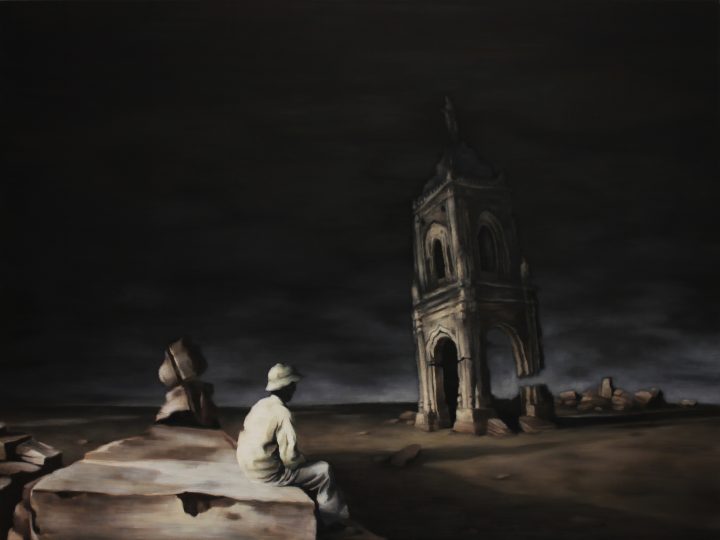When things fall apart
Against a backdrop of global collapse, one exhibition used Chinua Achebe’s classic to hold space for voices from the Global South—and asked who gets to imagine the future.

Nidaa Badwan (Palestine), One hundred days of solitude, 2014. Photo. Courtesy: the artist and the French Institute in Jerusalem.
- Interview by
- Riason Naidoo
Born in Dakar in 1967, N’Goné Fall completed her studies in Paris, first at Ecole supérieure d’arts graphiques (ESAG), graduating in 1986, and then architecture at the École Spéciale d’Architecture, where she presented her dissertation in 1993. While working as an architect, she became aware of Revue Noire magazine, and it was not long thereafter that she was working with the Revue Noire team (1994-2001), eventually taking over as editor. Her legacy project was the Anthology of African art: the twentieth century (2001), departing the publication house “with grandeur.” Fall was a cultural policy consultant for the foundations of Rockefeller, Prince Claus, Mondrian, the European Union, the ACP-EU Group, and the government of Senegal. She gave lectures at Senghor University in Alexandria, Egypt, at Abdou Moumouni University in Niger, and worked with the Nubuke Foundation in Ghana. General Commissioner of the Africa2020 Season, Fall led a project focusing on innovation in the arts, sciences, and entrepreneurship, and dedicated to the entire African continent that took place in France in 2021. The focus of this interview is on Fall’s career as a pioneering African woman curator since the 1990s, when there were very few black women’s voices in the field. One exhibition in particular, When Things Fall Apart: Critical Voices on the Radars (2016), curated at the Trapholt Museum in Denmark, caught my attention.

150 African masks, 20 school books, 12 plastic balls and chain, 100 wood piles,
41 drift wood pieces, 800 African brushes. 10 x 6 x 2,6m (L x W x H). Courtesy: the artist, Bildrecht Wien and Kunsthaus Bregenz.
How did you get into curating?
I was working with Revue Noire. We were publishing, but we were also ourselves discovering and sharing those discoveries. For us, it was an obvious step after publishing and having all these artists in the magazine; we said we can do more. We were a partner of the Dak’art Biennale in 1996 and decided to do an exhibition at the same time, which was the magazine issue on African artists and AIDS (published in 1995). We did a multimedia exhibition which we presented in the OFF of the Dak’art. That is how I started. We were also at the Bamako Encounters Photo Biennale that started the year before in 1994, with an exhibition of African photographers. So, we learnt curating from the ground up. What was really interesting about curating was that you were reaching out to an audience that might not read a magazine… I didn’t find the exhibitions that were happening in Paris in the 1990s interesting. I started paying attention to the Anglophone countries, looking at what was happening in London and the United States. At this time, curators were starting to be stars, people like Hans Ulrich Obrist. These discourses were so different from what museum curators were doing and saying in France. Voila! I got the connection with what these curators were doing. Anytime I was travelling outside of France, I was visiting exhibitions there. My training at the architecture school assisted because the emphasis was on creativity and concept. So with curating, I learnt on the job, and like anything, the more you do the better you get at it.
When I was a teenager in Dakar, I was living in the same neighborhood of Laboratoire Agit’Art in downtown Dakar. I was in that same cultural environment without being conscious of the impact of the artists, filmmakers, poets, etc. around me. I thought that this was completely normal to be surrounded by creative people. It was only when I was older that I realized that I was very, very lucky! I think all of these factors, where you grow up, the people around you, those that impact you, who contribute to who you are today. That was when I realized that curating is something that is impactful, powerful, and that I love doing.

What were some of the other exhibitions that you were involved in with Revue Noire?
The first one was the Bamako Encounters Photo Biennale (1994), then the Anthology of African Photography (1998) publication which was combined with a century of African photographs—400 photographs—that was first presented in Paris at Maison Européenne de la Photographie (1998), which became a touring exhibition that went to Berlin, London, New York, Washington DC, Bologna, São Paulo, Bamako and Cape Town. That’s how I first landed in Cape Town in December 1998, when the exhibition was presented at the South African National Gallery.
What have been your curatorial highlights?
Two projects are close to my heart for different reasons. One is called Contact Zone (2007). Samuel Sidibe, the director of the le Musée national du Mali (National Museum of Mali), commissioned me to do an exhibition to inaugurate the new building for contemporary exhibitions. I was thinking that people like myself we lack infrastructure on our continent. Our work was mainly in the West. Suddenly, you have an opportunity in this 700m2 building in Africa. I had to share this opportunity with my colleagues.
I called my partner in crime Bisi Silva, who had moved back to Lagos. Our meeting was obvious. I was a French-speaking West African based in Paris; she was an English-speaking West African based in London. It was the son of photographer J. D. ‘Okhai Ojeikere—who was one of the photographers I worked with in Lagos for Revue Noire—who introduced us. I am French speaking but I speak English; Bisi was English speaking, but she spoke French. That’s how we met in the late 1990s, and we made a promise that we would look after each other and be the best badasses in the world and fight all the possible fights together, and start mentoring young people.
I also invited Rachida Triki from Tunisia to work with me. The three of us drove Samuel crazy! I handled the catalogue process—edited, designed, and printed in Dakar—and had it delivered to Bamako. Bisi and I always talked about doing more projects together, but in retrospect, it was the only one we managed to do.
The other is When things Fall Apart: Critical voices on the radars because of the issues that I raised in that exhibition. I started working on it in 2015. Brexit was a hot topic in Europe; there was another wave of xenophobia in South Africa; you had the presidential campaign in the U.S. with Hillary Clinton and Donald Trump, and I felt that everything was collapsing in the world. I was talking to Pascale Marthine Tayou, who at that time was working on a solo show at the Serpentine gallery, who asked me to write an essay for his catalogue. I suggested to him to let’s rather have a conversation since we had known each other since 1994 and he participated in the show I curated in Dakar in 1996; I had squatted in his place, etc. We go back a long time! I was telling him about the commission for an exhibition in Denmark and that I was thinking about the title Things Fall Apart by Chinua Achebe. When I was growing up in Senegal, we read these books in school, all African writers translated into French; it was the time of Senghor. Pascale started laughing, and he said that he had just done a massive installation, which was called Things Fall Apart—10 meters long—and offered it to me for the exhibition, if I so wished.
I had also wanted to visit Southeast Asia to collaborate with some artists in Vietnam and Indonesia, and other artists in Central America, Palestine, and Africa. I curated that exhibition as if I was writing a novel: the first part on human rights, and the last part that ends on a more positive note on empathy. There were artists that I wanted to work with for a long time, artists that inspire me. There were a variety of works in the show, some very direct and some subtler. The exhibition ran for nine months, and we did reading clubs, where people read the novel in Danish and came to the museum to discuss. Actually, we invited the Danish to read an African classic novel and asked them to apply it to their own context.
Your catalogue text can be interpreted as quite a pessimistic view of the world.
A bit dramatic? That was my mindset in 2015/ 2016. But it ends with empathy, so more positively, to say there is a way out. I love writing, and for me there is no frontier between curating and writing. I was really lucky with this project to have the luxury of almost two years to go deep into the issues and then to come out with my own book.
In your text, you mention that Okonkwo’s tragic destiny—the chief protagonist in Achebe’s novel Things Fall Apart—is that he is unable to adapt to the changes taking place in society. Could this interpretation also not be the difference between assimilation and self-rule in the French and English colonies, respectively?
I think there are different ways to respond. You can say I surrender. Or you can say I surrender, but I kill a couple of thousand people before I surrender. You have different ways of resisting. If you do not take ownership of the weapons your enemy is using, there is no way out; so it depends on what is your methodology, what is your strategy? Being a black African Senegalese curator invited to do a project in a small town in Denmark—where people did not even know there were black African curators in Africa—that was my motivation! When I arrived there, it was seen that they were giving me an opportunity, but actually I educated them about Africa. So in a way, I colonised them. So that is what I mean when I say strategy. So I knew Okonkwo’s fate would end badly; he was too rigid. You know, when I was with Revue Noire, people were saying that there was no contemporary art in Africa, and now the same people want to tell me who Pascale Marthine Tayou is and who Barthélémy Toguo is.

You worked exclusively with socially engaged artists from the Global South. What was the logic behind this?
These artists stand for something. “If you don’t stand for something, you will fall for anything.” In Senegal, we felt a bit disconnected from the struggles of other Africans, in Angola, in South Africa, etc. My father was preparing for an independent Senegal, so we were always talking politics; we had an awareness that is in the DNA of my family. I was impressed by an artist like Tiffany Chung from Vietnam, who combines the poetic with the dramatic and has a strong concept along with the visual. It’s true that I was attracted by artists dealing with social, political, and economic issues because there are so many issues that we need to deal with on the [African] continent. So with my curating, my strategy was to colonise Denmark with African culture. What is the strategy? What do we Africans have to say to inspire other people, other cultures?
What made you reach out beyond contemporary African art in this exhibition?
Because the opportunity was there! Generally speaking, when you are an African curator, people only call you to do an African art show. That’s how it worked in the early 1990s and 2000s. I’m not sure if it has changed. In Denmark, I had carte blanche. The exhibition was part of a festival called Artists in Society, which is very broad. It was an opportunity to work with these different artists, whom I eventually included in the show. I expanded my African family to the Global South family. The other interesting fact is that the novel by Chinua Achebe, Things Fall Apart, has been translated into more than 50 languages. So when I reached out to the Vietnamese, they told me that it was the only African novel that they had ever read because it was the only one available in Vietnam. So all the artists from the different countries around the world read the novel for this exhibition.

Is When Things Fall Apart an African response to the exhibition The Divine Comedy–Heaven, Hell, Purgatory by Contemporary African Artists curated by Simon Njami in 2014? Is there any relationship to this exhibition?
There is absolutely no relationship at all. When I am thinking about an exhibition, I am not thinking about what other curators are doing or not doing. It’s more about what is in my mind at the time, what I am thinking about. My conversation with Tayou was confirmation that the novel is going to be the entry point. I had not seen The Divine Comedy exhibition. At the same time as I was busy with When Things Fall Apart, I was also a consultant for the Smithsonian Museum of African Art in Washington, drafting a new African women artist program, and they gave me a copy of the Divine Comedy catalogue. I didn’t open it; I still haven’t read it yet! I don’t position myself in response to other curators. That’s nonsense!
I was just wondering because I know that Njami was criticized for being too Eurocentric in his reference with the Divine Comedy show.
I am not Simon, and unlike Simon, I grew up in Dakar, and 90 percent of my time I have spent in the streets of Dakar speaking Wolof. I became Western-based when I came to do my studies in Paris in the mid-1980s. Even at Revue Noire, I was the one sent to these crazy countries that nobody wanted to go to. Eritrea was still at war; Angola was just coming out of the war. When you are young, you don’t think of the danger; it is only in retrospect that you realise the risks you took. I never think of myself as being part of the African diaspora. I’m a Senegalese. Voila! Sometimes I’m based in Europe, sometimes I’m based in the [African] continent, and sometimes I’m based in South Korea for three months. I’m a gypsy, but a Senegalese gypsy! It is true that my references are African. It is extremely important for me to share that African experience, African knowledge with the rest of the world. Others have their references, which are fine, but I have my references that others don’t know about. My role as a curator and as a writer would be to give access to that knowledge, so that while I am curating and writing, you can learn from the African experience. So Eurocentrism is the last thing you can accuse me of. It’s not going to happen! I was raised in a Pan-African mindset in my family, and I strongly believe in the power of African cultures. I can also be very Parisian, very New York, very Brussels; I adapt. Unlike Okonkwo, you adapt to your context, but you never forget who you are.
At the time you started curating in the 1990s with Revue Noire, were there any other women from the African continent also curating?
Bisi Silva! Bisi had graduated from the Royal College in London and was working as an independent curator in the United Kingdom. That’s why it was obvious that we had to meet. In 2001/02, she decided to move to Lagos and to continue her work there…



